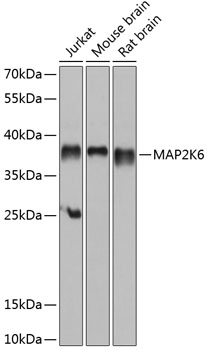| Background: | This gene encodes a member of the dual specificity protein kinase family, which functions as a mitogen-activated protein (MAP) kinase kinase. MAP kinases, also known as extracellular signal-regulated kinases (ERKs), act as an integration point for multiple biochemical signals. This protein phosphorylates and activates p38 MAP kinase in response to inflammatory cytokines or environmental stress. As an essential component of p38 MAP kinase mediated signal transduction pathway, this gene is involved in many cellular processes such as stress induced cell cycle arrest, transcription activation and apoptosis. |
| UniProt Protein Function: | Dual specificity protein kinase which acts as an essential component of the MAP kinase signal transduction pathway. With MAP3K3/MKK3, catalyzes the concomitant phosphorylation of a threonine and a tyrosine residue in the MAP kinases p38 MAPK11, MAPK12, MAPK13 and MAPK14 and plays an important role in the regulation of cellular responses to cytokines and all kinds of stresses. Especially, MAP2K3/MKK3 and MAP2K6/MKK6 are both essential for the activation of MAPK11 and MAPK13 induced by environmental stress, whereas MAP2K6/MKK6 is the major MAPK11 activator in response to TNF. MAP2K6/MKK6 also phosphorylates and activates PAK6. The p38 MAP kinase signal transduction pathway leads to direct activation of transcription factors. Nuclear targets of p38 MAP kinase include the transcription factors ATF2 and ELK1. Within the p38 MAPK signal transduction pathway, MAP3K6/MKK6 mediates phosphorylation of STAT4 through MAPK14 activation, and is therefore required for STAT4 activation and STAT4-regulated gene expression in response to IL-12 stimulation. The pathway is also crucial for IL-6-induced SOCS3 expression and down-regulation of IL-6-mediated gene induction; and for IFNG-dependent gene transcription. Has a role in osteoclast differentiation through NF-kappa-B transactivation by TNFSF11, and in endochondral ossification and since SOX9 is another likely downstream target of the p38 MAPK pathway. MAP2K6/MKK6 mediates apoptotic cell death in thymocytes. Acts also as a regulator for melanocytes dendricity, through the modulation of Rho family GTPases. |
| NCBI Summary: | This gene encodes a member of the dual specificity protein kinase family, which functions as a mitogen-activated protein (MAP) kinase kinase. MAP kinases, also known as extracellular signal-regulated kinases (ERKs), act as an integration point for multiple biochemical signals. This protein phosphorylates and activates p38 MAP kinase in response to inflammatory cytokines or environmental stress. As an essential component of p38 MAP kinase mediated signal transduction pathway, this gene is involved in many cellular processes such as stress induced cell cycle arrest, transcription activation and apoptosis. [provided by RefSeq, Jul 2008] |
| UniProt Code: | P52564 |
| NCBI GenInfo Identifier: | 1709088 |
| NCBI Gene ID: | 5608 |
| NCBI Accession: | P52564.1 |
| UniProt Related Accession: | P52564 |
| Molecular Weight: | 31,339 Da |
| NCBI Full Name: | Dual specificity mitogen-activated protein kinase kinase 6 |
| NCBI Synonym Full Names: | mitogen-activated protein kinase kinase 6 |
| NCBI Official Symbol: | MAP2K6 |
| NCBI Official Synonym Symbols: | MEK6; MKK6; MAPKK6; PRKMK6; SAPKK3; SAPKK-3 |
| NCBI Protein Information: | dual specificity mitogen-activated protein kinase kinase 6 |
| UniProt Protein Name: | Dual specificity mitogen-activated protein kinase kinase 6 |
| UniProt Synonym Protein Names: | MAPK/ERK kinase 6; MEK 6; Stress-activated protein kinase kinase 3; SAPK kinase 3; SAPKK-3; SAPKK3 |
| Protein Family: | Dual specificity mitogen-activated protein kinase kinase |
| UniProt Gene Name: | MAP2K6 |







